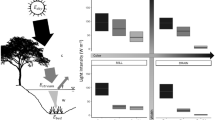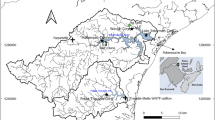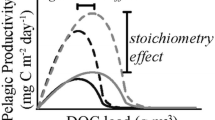Abstract
The emerging spatial scale of interest for fluvial ecosystem studies and applications is the river basin. Although much focus has been directed toward habitat availability and nutrient cycling across the fluvial landscape, light availability has received considerably less attention and has not been assessed quantitatively at the basin-scale despite it being the primary energy source for aquatic ecosystems. We developed a basin-scale light availability model that couples readily available broad spatial data with easily measured synoptic data using a GIS framework and the principles of hydraulic geometry. We used this model to (i) quantify benthic light availability (E bed) along a 160-km river in central Wisconsin, USA, (ii) predict gross primary production (GPP) along the same river, and (iii) assess the effects of agricultural land use on E bed and GPP. Overall, E bed decreased in the downstream direction due primarily to increased turbidity, and there was considerable local variation caused by changes in topography, riparian vegetation, and channel orientation. These local variations in E bed caused GPP to fluctuate greatly over short distances, as much as 2.1 g C m−2 d−1 over 260 m. When summed over the entire channel length, present-day, post-agricultural GPP (635 kg C d−1) was about eight times lower than estimated pre-agricultural GPP (4992 kg C d−1). Model simulations revealed that agricultural land use can cause an order of magnitude change in GPP, reduce or increase inter-sectional variability in GPP, and significantly alter broad spatial trends in GPP. Our basin-scale benthic light availability model is a tool that researchers can use to investigate relationships between light availability and ecosystem processes at broad spatial scales and also one that practitioners can use for more holistic fluvial ecosystem assessments.









Similar content being viewed by others
References
Alexander RB, Smith RA. 2006. Trends in nutrient enrichment of U.S. rivers during the 20th century and their relation to probable stream trophic conditions. Limnol Oceanogr 51: 639–54
Basher LR. 2003. The Motueka and Riwaka catchments: a technical report summarising the present state of knowledge of the catchments, management issues and research needs for integrated catchment management. Manaaki Whenua Landcare Research, Lincoln, pp. 122
Benda L, Poff NL, Miller D, Dunne T, Reeves G, Pess G, Pollock M. 2004. The network dynamics hypothesis: how channel networks structure riverine habitats. BioScience 54: 413–27
Curtis JT. 1959. The vegetation of Wisconsin. The University of Wisconsin Press, Madison
Davies-Colley RJ. 1990. Frequency distributions of visual water clarity in 12 New Zealand rivers. NZ J Marine Freshw Res 24: 453–60
Davies-Colley RJ, Vant WN, Smith DG. 2003. Colour and clarity of natural waters. Ellis Horwood, New York
Dodds WK, Biggs BJF, Lowe RL. 1999. Photosynthesis-irradiance patterns in benthic microalgae: variations as a function of assemblage thickness and community structure. J Phycol 35: 42–53
Dodds WK, Welch EB. 2000. Establishing nutrient criteria in streams. J N Am Benthol Soc 19: 186–96
Frazer GW, Canham CD, Lertzman KP 1999. Gap light analyzer (GLA), version 2.0: imaging software to extract canopy structure and gap light transmission indices from true-colour fisheye photographs, users manual and program documentation. Simon Fraser University and Institute of Ecosystem Studies, Burnaby, B.C. and Millbrook, NY, pp. 40
Fu P, Rich PM. 2000. The Solar Analyst 1.0 manual. HELIOS Environmental Modeling Institute, USA, pp. 53
Graf WL. 1975. The impact of suburbanization on fluvial geomorphology. Water Resour Res 11: 690–2
Greenwood JL, Rosemond AD. 2005. Periphyton response to long-term nutrient enrichment in a shaded headwater stream. Can J of Fish Aquat Sci 62: 2033–45
Hammer TR. 1972. Stream channel enlargement due to urbanization. Water Res Res 8: 1530–40
Harvey MD, Watson CC, Schumm SA. 1984. Channelized streams: an analog for the effects of urbanization. In: Sterling H.J. (Ed.), International symposium on urban hydrology, hydraulics and sediment control. University of Kentucky, Lexington, KY, pp. 401–9
Hawkins CP. 1986. Variation in individual growth rates and population densities of ephemerellid mayflies. Ecology 67: 1384–95
Hawkins CP, Murphy ML, Anderson NH. 1982. Effects of canopy, substrate composition, and gradient on the structure of macroinvertebrate communities in Cascade Range streams of Oregon. Ecology 63: 1840–56
Hilton J, O’Hare M, Bowes MJ, Jones JI. 2006. How green is my river? A new paradigm of eutrophication in rivers. Sci Total Environ 365: 66–83
Jassby AD, Platt T. 1976. Mathematical formulation of the relationship between photosynthesis and light for phytoplankton. Limnol Oceanogr 21: 540–7
Johnson LB, Richards C, Host GE, Arthur JW. 1997. Landscape influences on water chemistry in Midwestern stream ecosystems. Freshw Biol 37: 193–208
Julian JP, Doyle MW, Powers SM, Stanley EH, Riggsbee JA. 2008a. Optical water quality in rivers. Water Resour Res. doi:10.29/2007WR006457, in press
Julian JP, Doyle MW, Stanley EH. 2008b. Empirical modeling of light availability in rivers. J Geophys Res Biogeosci 113:G03022. doi:10.1029/2007JG000601
Kiffney PM, Greene CM, Hall JE, Davies JR. 2006. Tributary streams create spatial discontinuities in habitat, biological productivity, and diversity in mainstem rivers. Can J Fish Aquat Sci 63: 2518–30
Leopold LB, Maddock T Jr. 1953. The hydraulic geometry of stream channels and some physiographic implications. USGS Professional Paper 252, pp 1–57
Lin LS, Markus M, Russell A. 2007. Stream classification system based on susceptibility to algal growth response to nutrients. J Environ Eng 133: 692–7
Maidment DR 2002. Arc hydro: GIS for water resources. Center for Research in Water Resources, University of Texas, Austin
Mayer MS, Likens GE. 1987. The importance of algae in a shaded headwater stream as food for an abundant caddisfly (Trichoptera). J N Am Benthol Soc 6: 262–9
McNeely C, Finlay JC, Power ME. 2007. Grazer traits, competition, and carbon sources to a headwater stream food web. Ecology 88: 391–401
Millennium Ecosystem Assessment (MEA). 2005. Ecosystems and human well-being: synthesis. Island Press, Washington, DC
Montgomery DR. 1999. Process domains and the river continuum. J Am Water Resour Assoc 35: 397–410
Nilsson C, Reidy CA, Dynesius M, Revengz C. 2005. Fragmentation and flow regulation of the world’s large river systems. Science 308: 405–8
Osterkamp WR, Hedman ER. 1977. Variation of width and discharge for natural high-gradient stream channels. Water Resour Res 13: 256–8
Rhoads BL. 1987. Changes in stream channel characteristics at tributary junctions. Phys Geogr 8: 346–61
Rice SP, Greenwood MT, Joyce CB. 2001. Tributaries, sediment sources, and the longitudinal organisation of macroinvertebrate fauna along river systems. Can J Fish Aquat Sci 58: 824–40
Roberts BJ, Mulholland PJ, Hill WR. 2007. Multiple scales of temporal variability in ecosystem metabolism rates: results from 2 years of continuous monitoring in a forested headwater stream. Ecosystems 10: 588–606
Robertson DM, Graczyk DJ, Garrison PJ, Wang L, LaLiberte G, Bannerman R. 2006. Nutrient concentrations and their relations to the biotic integrity of wadeable streams in Wisconsin. U.S. Geological Survey Professional Paper 1722
Scudder BC, Stewart JS. 2001. Benthic algae of benchmark streams in agricultural areas of Eastern Wisconsin. U.S. Geological Survey, Middleton, WI, p. 54
Simon A. 1992. Energy, time, and channel evolution in catastrophically disturbed fluvial systems. Geomorphology 5: 345–72
Smith SV, Renwick WH, Bartley JD, Buddemeier RW. 2002. Distribution and significance of small, artificial water bodies across the United States. Sci Total Environ 299: 21–36
U.S. Department of Agriculture (USDA). 2007. UV-B Monitoring and Research Program, http://uvb.nrel.colostate.edu/UVB/
Vannote RL, Minshall GW, Cummins KW, Sedell JR, Cushing CE. 1980. The river continuum concept. Can J Fish Aquat Sci 37: 130–7
Von Schiller D, Marti E, Riera JL, Sabater F. 2007. Effects of nutrients and light on periphyton biomass and nitrogen uptake in Mediterranean streams with contrasting land use. Freshw Biol 52: 891–906
Walling DE, Fang D. 2003. Recent trends in the suspended sediment loads of the world’s rivers. Global Planet Change 39: 111–26
Wisconsin Department of Natural Resources (WDNR). 2006. Wisconsin Dam Database, http://dnr.wi.gov/org/water/wm/dsfm/dams/datacentral.html
Wisconsin Department of Natural Resources (WDNR). 1998. Landcover Data (WISCLAND), http://dnr.wi.gov/maps/gis/datalandcover.html
Wolman MG. 1967. A cycle of sedimentation and erosion in urban river channels. Geografiska Annaler 49A: 385–95
Acknowledgments
The project was supported by the National Research Initiative of the USDA Cooperative State Research, Education, and Extension Service (CSREES grant # 2004-35102-14793). Steve Powers and Ryan Kroiss assisted with field and laboratory work. This manuscript also benefited from the comments of two anonymous reviewers.
Author information
Authors and Affiliations
Corresponding author
Additional information
J. P. Julian conceived and designed the study, performed the research, analyzed the data, and wrote the manuscript. E. H. Stanley helped design the study, assisted with writing, and contributed editorial input. M. W. Doyle helped design the study and contributed editorial input.
Rights and permissions
About this article
Cite this article
Julian, J.P., Stanley, E.H. & Doyle, M.W. Basin-Scale Consequences of Agricultural Land Use on Benthic Light Availability and Primary Production Along a Sixth-Order Temperate River. Ecosystems 11, 1091–1105 (2008). https://doi.org/10.1007/s10021-008-9181-9
Received:
Revised:
Accepted:
Published:
Issue Date:
DOI: https://doi.org/10.1007/s10021-008-9181-9




